There’s a certain magic in cultivating your own peppers, especially when space is tight and you need to think outside the traditional garden bed. Container gardening isn’t just a compromise; it’s a smart, versatile strategy for both novice and seasoned gardeners to indulge their pepper passions. Whether you live in a bustling city apartment or simply want to maximize every inch of your garden space, growing peppers in containers offers a vibrant and fruitful endeavor that can be tailored to suit your needs and aspirations.
This article will guide you through 13 effective strategies to nurture healthy, productive pepper plants right from the confines of a container. From selecting the perfect pepper varieties to mastering watering techniques, you’ll discover how to turn your balcony, patio, or even your windowsill into a thriving oasis of color and flavor. Whether you’re trying your hand at gardening for the first time or looking to refine your pepper-growing prowess, these tips will empower you with practical knowledge and confidence. Get ready to embark on a gardening adventure that promises not just a harvest, but a journey of growth and discovery.
Choosing Pepper Varieties for Pots
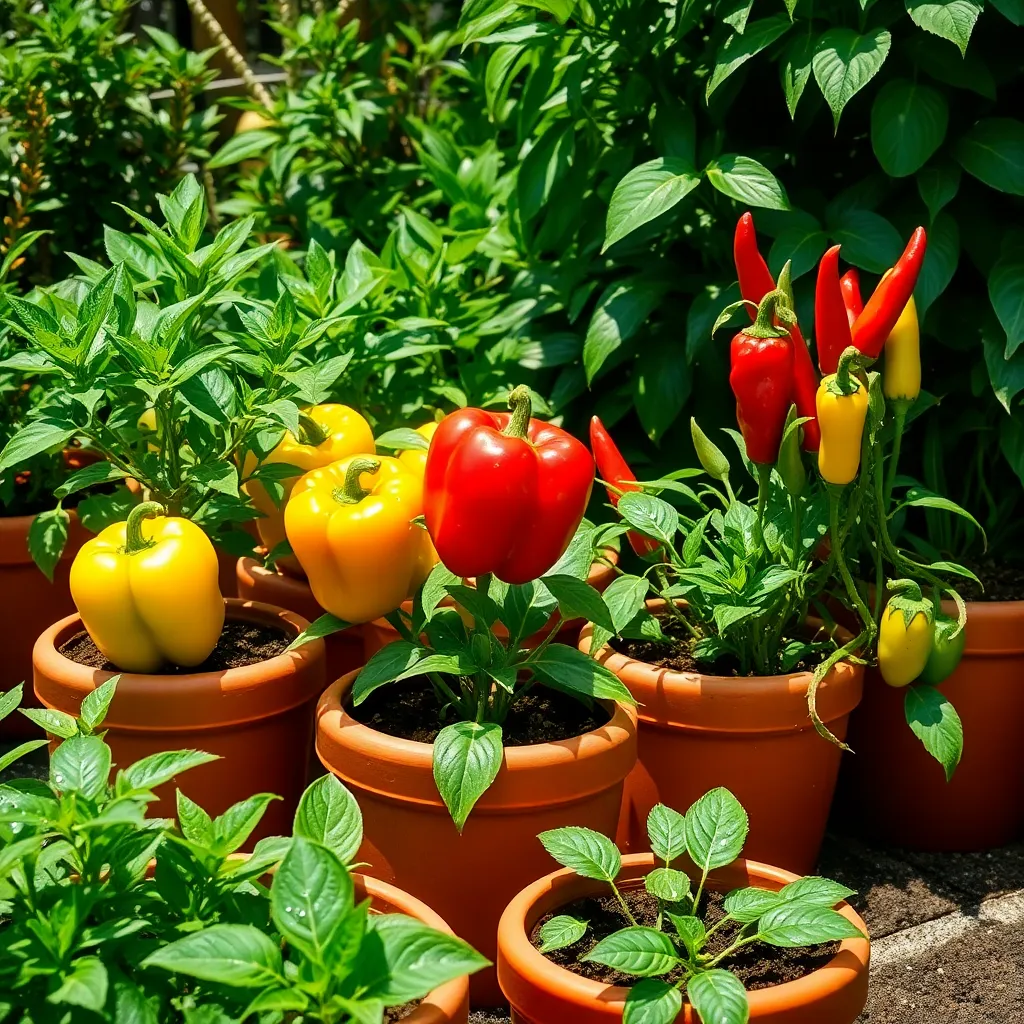
When choosing pepper varieties for pots, start by considering the size of the plant and the pot. Smaller varieties like ‘Jalapeno’, ‘Cayenne’, and ‘Habanero’ are perfect for containers due to their compact growth habit.
Next, evaluate the climate and growing conditions you can provide. Peppers generally thrive in warm environments, so choosing a sunny spot and using black pots can help absorb heat and promote growth.
For an ideal potting mix, combine equal parts of high-quality potting soil, perlite, and compost. This blend ensures good drainage, aeration, and nutrient availability, which are crucial for container-grown peppers.
It’s also important to consider the pot size relative to the variety you choose. A pot with a minimum depth of 12 inches is recommended for most pepper plants, but larger varieties may require even more space.
Watering frequency is another critical aspect; peppers in pots may need watering more often than those in the ground. Aim to keep the soil consistently moist but not waterlogged, especially during hot weather.
For an added boost, use a balanced liquid fertilizer every two weeks during the growing season. This will ensure your peppers have access to essential nutrients for robust growth and prolific fruiting.
Selecting the Ideal Container Size

When growing peppers in containers, selecting the ideal container size is crucial for healthy plant development. A pot that is too small can stunt growth, while one that is too large may lead to overwatering issues.
For most pepper varieties, a container with a minimum capacity of 5 gallons is recommended. This size allows enough room for root expansion and provides adequate support for the plant as it grows.
If you’re growing larger pepper varieties, consider using containers that hold 10 gallons or more. This extra space will accommodate the more extensive root systems and help prevent the plant from becoming root-bound.
Ensure your containers have drainage holes to prevent waterlogging, which can lead to root rot. Placing a layer of gravel or broken pottery at the bottom can further improve drainage.
Use a high-quality potting mix that retains moisture yet drains well, such as a blend with peat moss, perlite, and vermiculite. Water your peppers regularly, but allow the top inch of soil to dry out between waterings to avoid overwatering.
For experienced gardeners, consider self-watering containers to maintain consistent soil moisture levels, especially during hot weather. These containers can help reduce the frequency of watering and ensure your peppers thrive in optimal conditions.
Quality Potting Mix Essentials

Choosing the right potting mix is crucial for growing healthy peppers in containers. A high-quality potting mix provides the necessary nutrients and drainage essential for pepper plants to thrive in confined spaces.
Opt for a potting mix that is specifically formulated for container gardening. These mixes typically include a blend of peat moss, perlite, and vermiculite, which ensures proper aeration and moisture retention.
Enrich the potting mix by adding compost or well-rotted manure to provide additional nutrients. This organic matter will improve soil fertility, encouraging robust root development and higher yields.
For gardeners looking to optimize growth, consider adding a slow-release fertilizer to the potting mix before planting. This ensures that your pepper plants receive a steady supply of nutrients throughout the growing season.
Sunlight Needs for Container Peppers
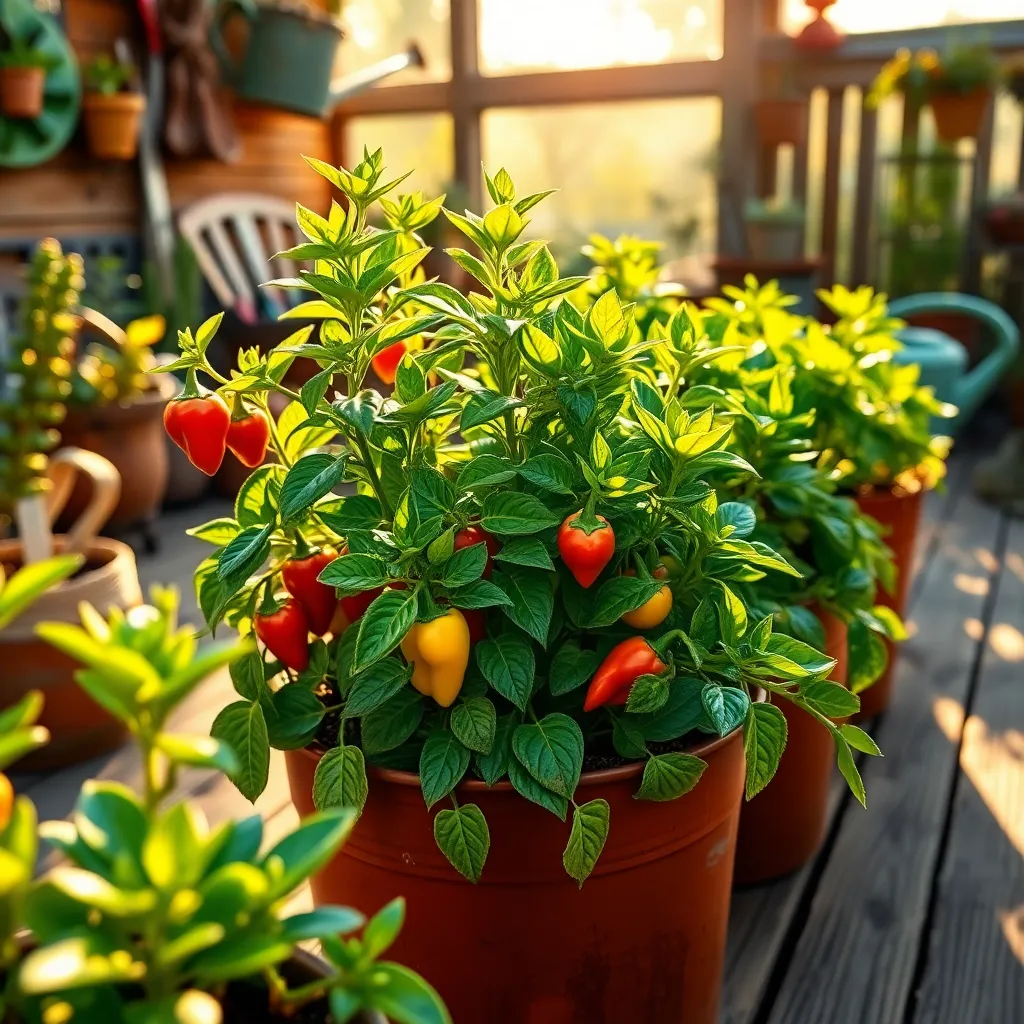
Peppers thrive in containers when they receive adequate sunlight, which is critical for healthy growth. Generally, peppers need at least 6-8 hours of direct sunlight each day, making a sunny spot on a patio or balcony ideal for their placement.
If you’re just starting, choose a location that receives morning sunlight, as it is often less intense and beneficial for early growth stages. To maximize sunlight exposure, consider rotating your containers regularly, ensuring all sides of the plant receive equal light.
For those looking to optimize pepper production, consider supplementing natural light with grow lights, especially in areas with shorter daylight hours. LED grow lights can be a great option as they are energy-efficient and can be adjusted to provide the ideal spectrum of light for pepper plants.
It’s important to observe your peppers for any signs of inadequate sunlight, such as leggy growth or pale leaves. If you notice these signs, gradually increase their daily light exposure to prevent shock and encourage robust growth.
Proper Watering Techniques for Growth
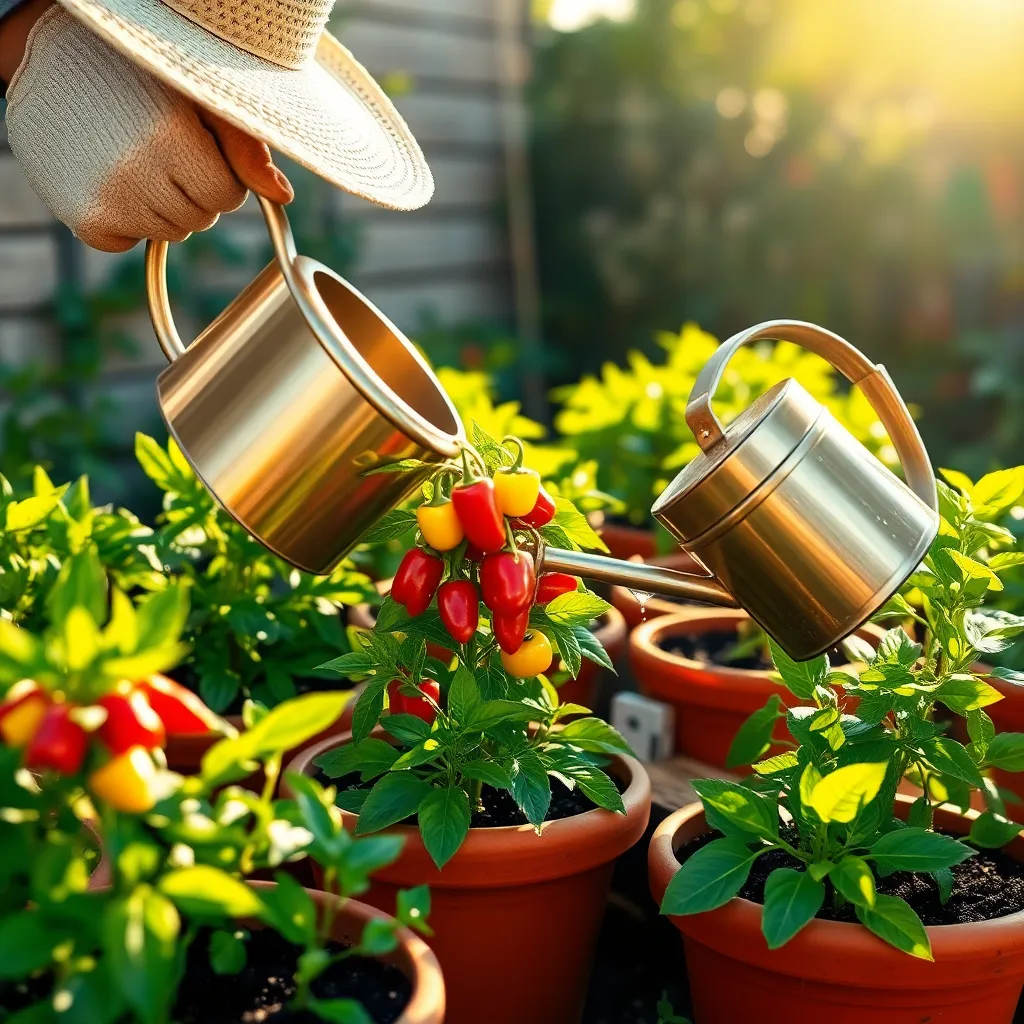
Watering your container peppers correctly is crucial for ensuring healthy growth and bountiful yields. Always check the soil moisture before watering; peppers dislike both soggy and overly dry conditions.
To determine the right time to water, insert your finger about an inch into the soil. If it feels dry at this depth, it’s time to water your peppers thoroughly until water drains from the bottom of the container.
Consider the weather when planning your watering schedule, as hot and sunny conditions may require more frequent watering. On cooler or cloudier days, reduce the frequency to prevent waterlogging, which can lead to root rot.
For more advanced care, using a moisture meter can help you keep track of precise soil conditions. Additionally, mulching the soil surface with organic material such as straw or wood chips can help retain moisture and reduce evaporation.
Fertilizing Strategies for Vigorous Growth
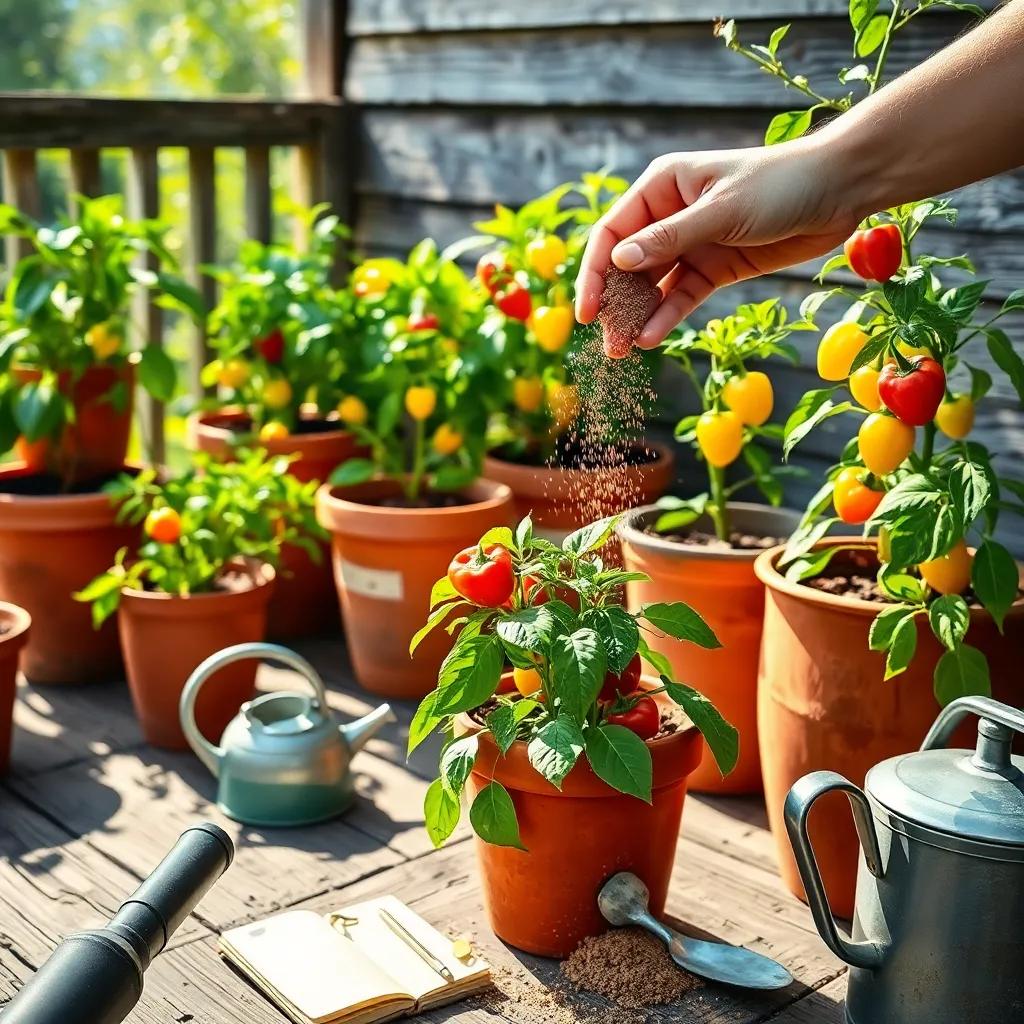
To ensure your pepper plants thrive in containers, it’s crucial to incorporate a balanced fertilizing strategy. Begin with a well-draining potting mix rich in organic matter, as this provides a steady supply of nutrients for your plants.
Start with a slow-release granular fertilizer when planting your peppers. This initial boost will support root development and promote vigorous early growth, laying a strong foundation for your plants.
As your peppers grow, supplement with a liquid fertilizer every two to three weeks. Opt for a fertilizer high in phosphorus and potassium, which encourages flowering and fruit production.
For more advanced gardeners, consider conducting a soil test to fine-tune your fertilization strategy. Adjusting the nutrient balance based on soil test results can significantly enhance plant health and productivity.
Managing Drainage and Moisture Levels
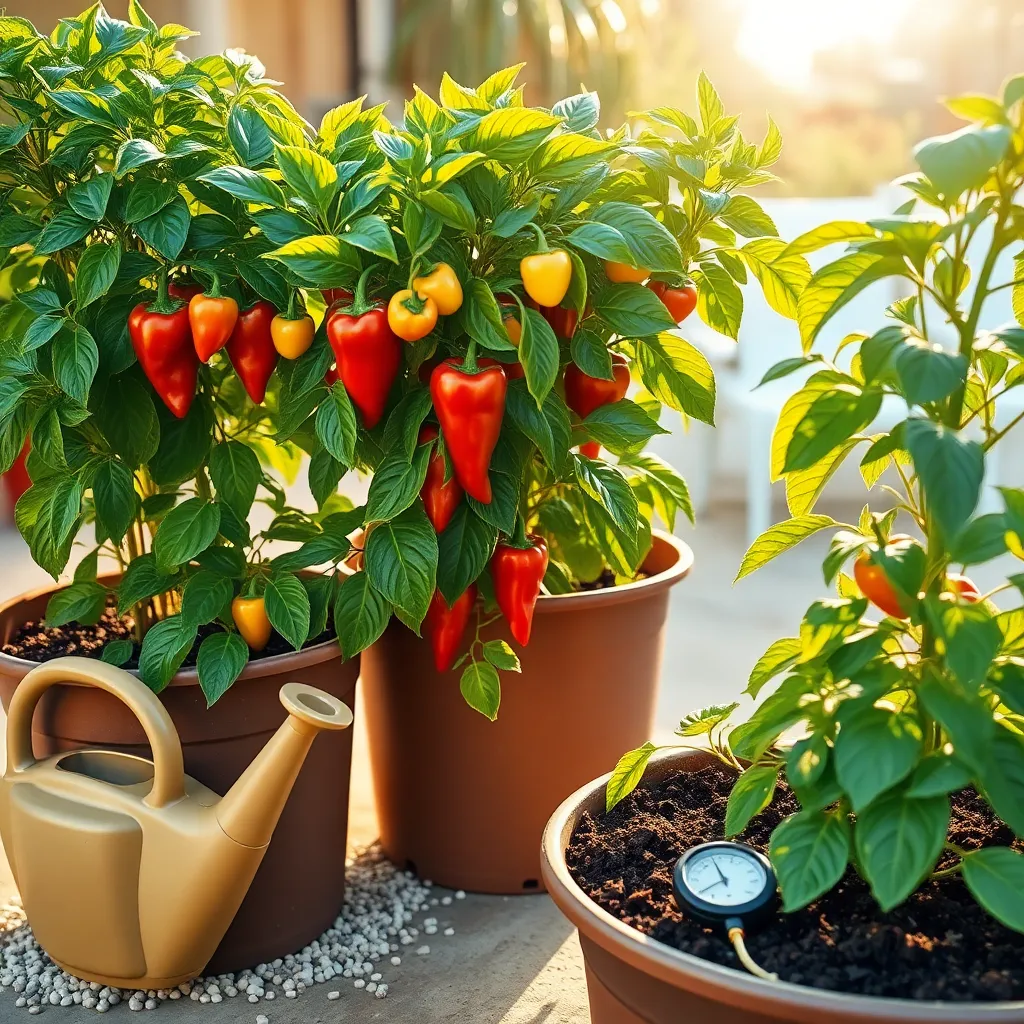
Proper drainage is crucial when growing peppers in containers to prevent root rot and other moisture-related problems. To achieve this, ensure your containers have adequate drainage holes and consider adding a layer of gravel or broken pottery at the bottom to improve water flow.
Using the correct soil mix is vital for managing moisture levels effectively. Opt for a high-quality potting mix that includes ingredients like perlite or vermiculite, which help retain moisture while allowing excess water to drain away.
Watering peppers in containers requires a balance between keeping the soil consistently moist and avoiding overwatering. As a general rule, water your peppers when the top inch of soil feels dry to the touch, and ensure water drains freely from the bottom of the container.
Monitoring humidity levels can also impact the success of your pepper plants. For those living in dry climates, consider placing a shallow tray of water near the base of your containers or misting the plants occasionally to maintain adequate humidity.
Companion Planting for Peppers

Companion planting is a powerful strategy to enhance the growth and health of peppers in containers. By carefully selecting which plants to grow alongside your peppers, you can naturally deter pests and improve soil fertility.
Consider planting basil near your peppers, as it can help repel aphids, spider mites, and mosquitoes. Additionally, basil is known to enhance the flavor of peppers, making it a dual-purpose companion.
Planting onions or garlic alongside peppers can provide a natural defense against common pests such as aphids and beetles. These alliums release sulfur compounds that act as a natural insecticide, reducing the need for chemical interventions.
For gardeners with more experience, interplanting marigolds with peppers is an excellent strategy. Marigolds can deter nematodes and other harmful soil organisms while adding a splash of color to your container garden.
Pruning and Supporting Pepper Plants
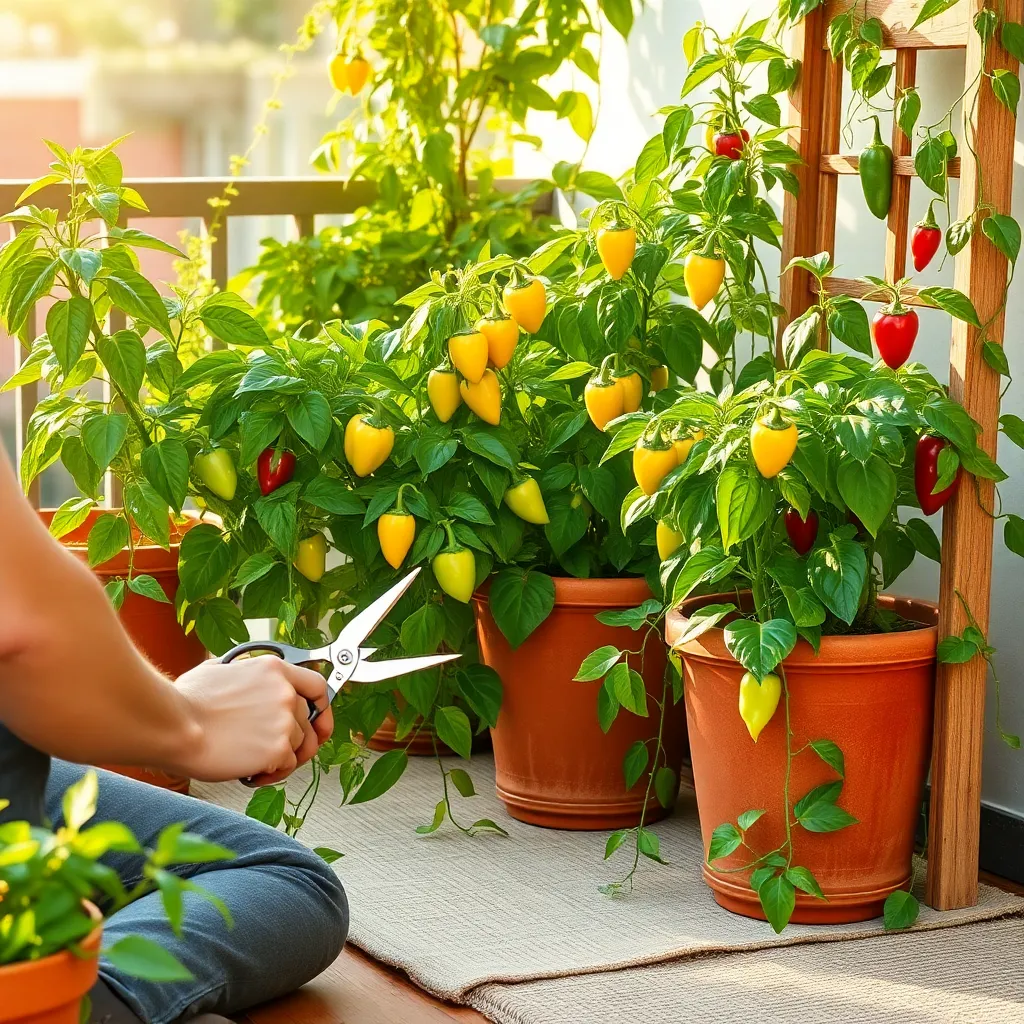
Pruning pepper plants is a crucial step in ensuring they grow strong and healthy. By removing unnecessary foliage, you can improve air circulation and focus the plant’s energy on fruit production.
Start by identifying and cutting off any dead or yellowing leaves, as well as any branches growing toward the center of the plant. This encourages better airflow and reduces the risk of diseases that thrive in moist environments.
As your pepper plants grow, consider removing some of the lower leaves to prevent soil-borne diseases. Keep your pruning tools clean to avoid transferring any pathogens between plants.
Supporting your pepper plants is equally important, as it helps them bear the weight of their fruits. Use a simple stake or cage to provide the necessary support once your plants reach about a foot in height.
Secure the main stem to the stake with soft ties, like garden twine or strips of cloth, to avoid damaging the plant. Staking not only keeps your plants upright but also prevents them from breaking in strong winds or heavy rains.
Finally, as your peppers develop, continue to monitor their growth and adjust supports as needed. This consistent care will maximize your harvest and keep plants healthy throughout the growing season.
Pest and Disease Control Tips
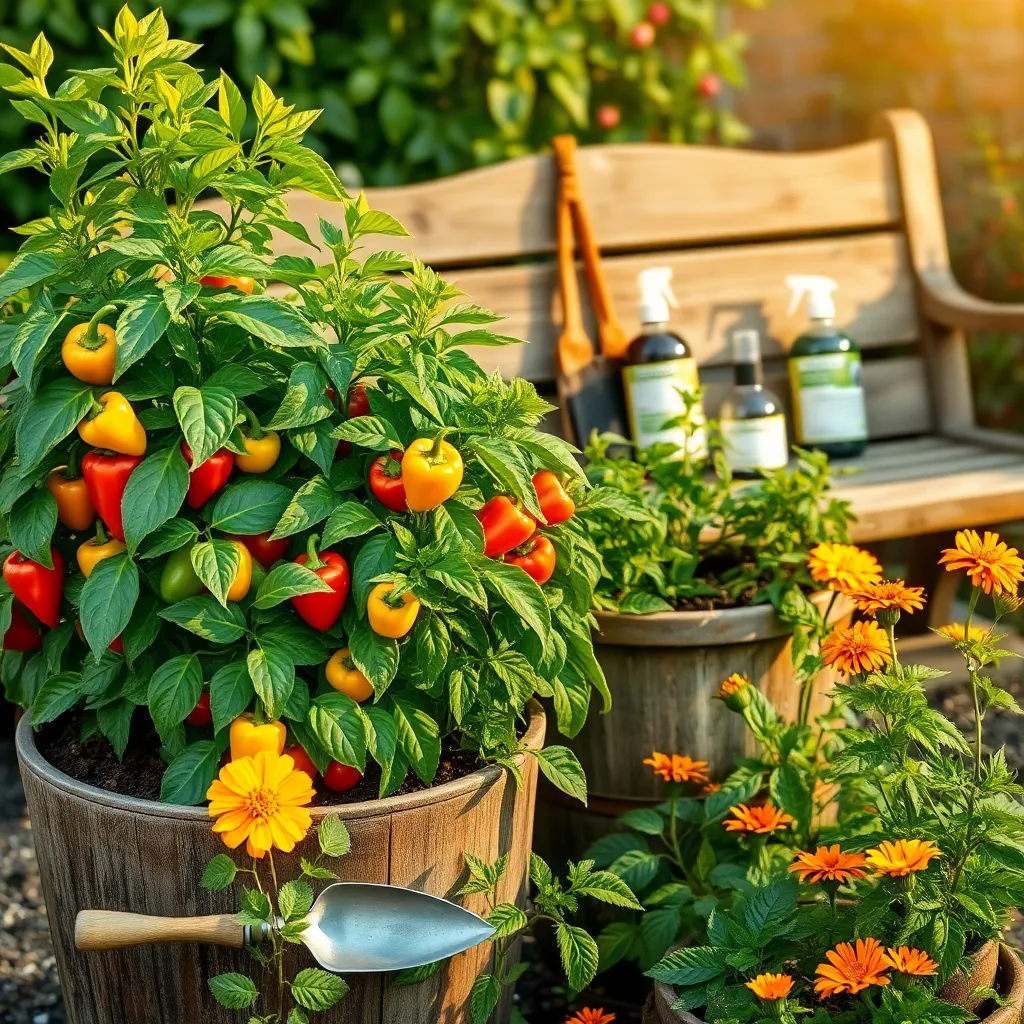
To effectively manage pests and diseases when growing peppers in containers, start by selecting disease-resistant varieties. This simple choice can prevent numerous common issues and save you a lot of trouble in the long run.
Regular inspection of your pepper plants is crucial for early detection of potential problems. Look for signs such as yellowing leaves or unusual spots, which can indicate pest infestations or diseases.
Maintaining proper hygiene around your plants is another essential step. Always remove any fallen leaves or debris from the soil surface to prevent the spread of fungi and bacteria.
Consider implementing natural pest control methods to minimize chemical use. Introducing beneficial insects like ladybugs can help keep aphid populations in check.
For those dealing with persistent pest issues, a homemade spray using neem oil can be effective. Mix a small amount of neem oil with water and a few drops of mild dish soap, then apply it to affected areas.
Ensuring your plants have adequate air circulation can also reduce disease risk. Space your pots appropriately and consider pruning excess foliage to improve airflow.
Overwintering Pepper Plants in Containers
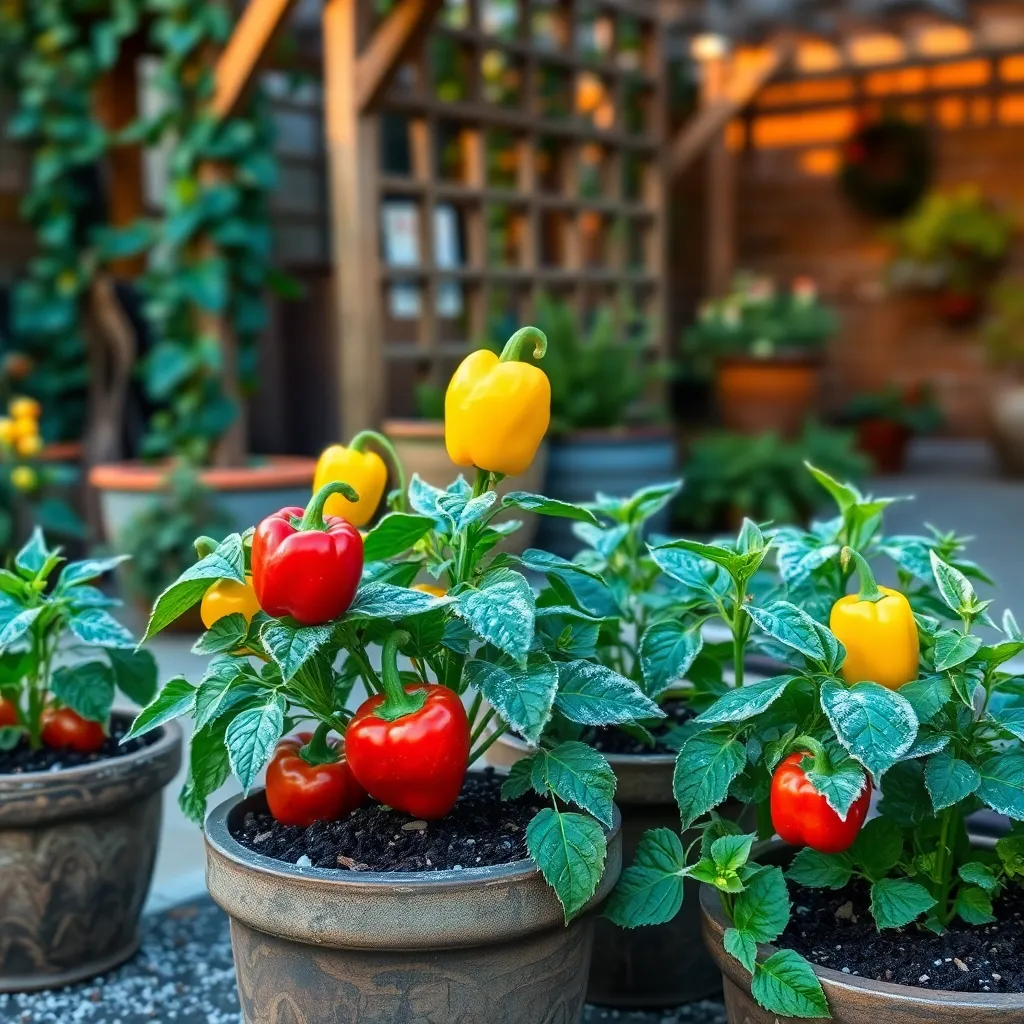
Overwintering pepper plants in containers can be a rewarding way to extend their lifespan beyond a single growing season. To begin, choose a suitable container that allows adequate drainage and has enough space for the root system, typically at least 12 inches deep.
Before the first frost, transition your pepper plants indoors by gradually acclimating them to lower light conditions. Start by moving them to a shaded area outdoors for a few hours each day, which helps minimize stress once they are fully indoors.
Once inside, place your plants in a sunny spot, such as a south-facing window, where they can receive at least six hours of sunlight daily. If natural light is insufficient, consider using grow lights to supplement their light needs, keeping them on for 12-16 hours a day.
Regarding watering, be cautious not to overwater your pepper plants during the winter months. Allow the top inch of the soil to dry out between waterings, as cooler indoor temperatures and reduced sunlight slow down their growth and water needs.
Avoid fertilizing your pepper plants heavily during the overwintering period. A light feeding with a balanced, water-soluble fertilizer once a month is sufficient to maintain their health without encouraging excessive growth.
Regularly check for pests like aphids or spider mites, which can thrive indoors. Inspect leaves and stems weekly and, if necessary, treat infestations with insecticidal soap or neem oil, ensuring you follow the product instructions carefully.
Harvesting Peppers at the Right Time
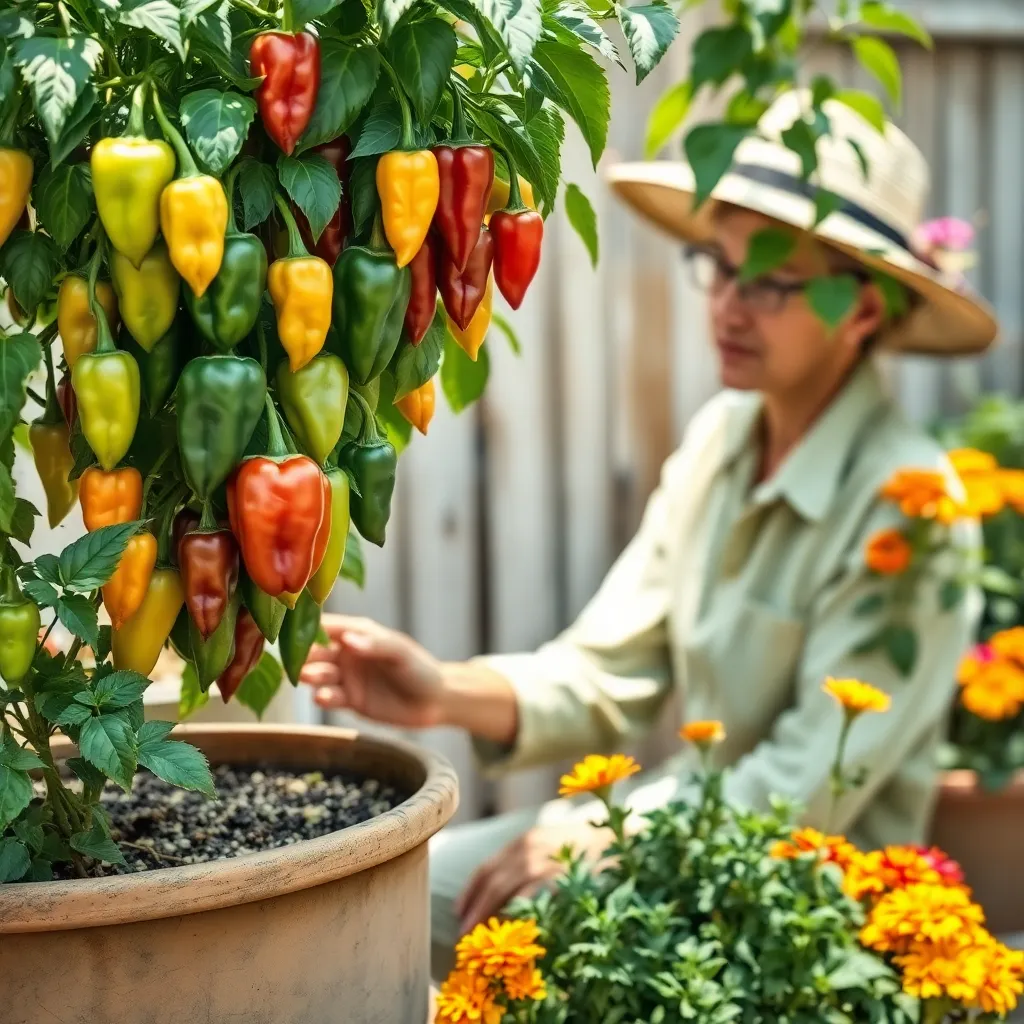
Timing is everything when it comes to harvesting peppers, and knowing when to pick can make a significant difference in flavor and yield. Generally, peppers should be picked when they have reached their mature color, which could be red, yellow, orange, or purple, depending on the variety.
To determine if your peppers are ready for harvest, gently squeeze them—they should feel firm and glossy. It’s important to use a pair of clean, sharp scissors or pruning shears to cut the peppers from the plant, leaving a small portion of the stem attached.
If you’re growing peppers in containers, consider rotating the containers every few days to ensure even sun exposure, which can help with uniform ripening. Additionally, consistent watering is crucial; aim to keep the soil moist but not soggy, as fluctuations can affect the sweetness and texture of the peppers.
For those looking to enhance their gardening skills, try experimenting with leaving some peppers on the plant longer to deepen their flavor profile. However, be mindful that leaving them too long may reduce the overall productivity of the plant as it focuses its energy on maturing seeds.
Maximizing Yields with Successive Planting

Successive planting is a powerful technique to maximize your yields when growing peppers in containers. By staggering your planting times, you can enjoy a continuous harvest throughout the growing season rather than a single, overwhelming bounty.
To implement successive planting, start by planting your first batch of pepper seedlings in early spring. About two to three weeks later, plant another round of seeds or seedlings to ensure a steady supply of peppers as the season progresses.
Selecting the right containers is crucial for successive planting; choose pots that are at least 12 inches in diameter to allow ample root space. Ensure your containers have adequate drainage holes to prevent waterlogging, which can stunt plant growth and lead to root rot.
For optimal growth, use a high-quality potting mix rich in organic matter, such as a blend containing peat moss, perlite, and compost. Peppers thrive in well-draining soil, so avoid garden soil in containers, as it can compact and hinder root development.
Water consistently, aiming to keep the soil moist but not soggy, and always water at the base of the plants to minimize the risk of fungal diseases. Consider using a drip irrigation system for more precise and efficient watering, especially if you’re managing multiple container plants.
As your peppers grow, feed them with a balanced fertilizer every two weeks to support their development. Look for fertilizers that have a slightly higher potassium and phosphorus content to encourage fruiting, such as a 5-10-10 mix.
Conclusion: Growing Success with These Plants
In nurturing relationships, much like growing peppers in containers, the right conditions and care are essential. This article explored 13 key concepts to cultivate thriving connections: understanding needs, effective communication, setting boundaries, mutual respect, shared goals, emotional support, adaptability, quality time, conflict resolution, trust-building, appreciation, patience, and celebrating growth together. Each principle serves as a vital ingredient in creating a lasting and fulfilling bond.
Now, take a moment to reflect on which area you’d like to enhance in your relationship. Choose one principle to focus on this week, whether it’s dedicating more quality time or improving communication, and make a conscious effort to integrate it into your daily interactions.
As you embark on this journey of growth, remember to save this article for future reference. Bookmarking it ensures you have a guide at your fingertips whenever you need a reminder or fresh inspiration to nurture your relationship.
Looking ahead, by embracing these principles, you’re setting the stage for a successful and enriching relationship journey. Every step you take strengthens the foundation of love and understanding, leading to a future filled with flourishing connections.







